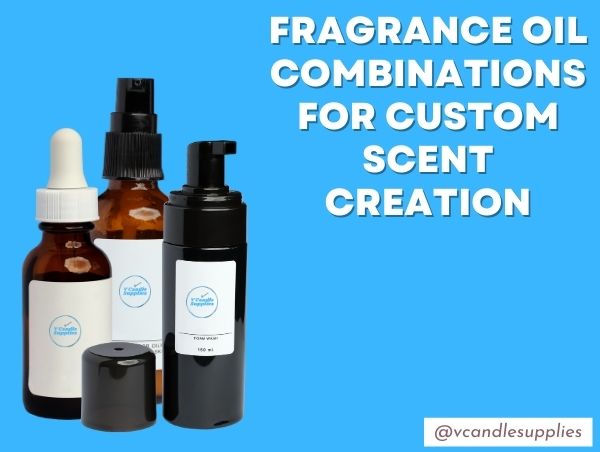COD available for orders below 1500. Shipping Charges will be added at the end while placing the order. Happy Candle 🕯️ Making. Dispatch Timeline - 3 to 4 days minimum due to peak season.
Fragrance Oil Combinations for Custom Scent Creation – A Step-by-Step Guide

Fragrance blending is a fascinating and creative process that allows you to craft unique and personalized scents.
Whether making perfumes, candles, soaps, or body products, understanding the science and artistry behind fragrance blending can help create harmonious and long-lasting aromas.
Let’s explore the fundamentals of fragrance blending, from understanding fragrance notes to different blending techniques, safety considerations, and popular fragrance combinations.
Fragrance Notes
Fragrances are composed of layers known as top, middle (heart), and base notes:
- Top Notes: These are the initial scents perceived and are typically light and refreshing, such as citrus or herbal aromas.
- Middle Notes: Emerging after the top notes dissipate, middle notes form the fragrance’s core, often featuring floral or fruity scents.
- Base Notes: These provide depth and longevity with rich, heavy scents like woods, resins, or musks.
A harmonious blend balances these notes, creating a well-rounded and appealing fragrance.
What Safety Considerations Should Be Followed in Fragrance Blending?
- Allergen Awareness: Some fragrance oils can cause allergic reactions. Always check ingredient lists and perform a patch test before applying directly to the skin.
- Proper Dilution: Ensure that fragrance oils are properly diluted according to recommended guidelines to prevent skin irritation.
- Safe Storage: Store fragrance oils in cool, dark places to maintain their quality and prevent degradation.
Different Fragrance Blending Techniques
Blending by Note
- Complementary Notes: Combine scents from different categories that naturally harmonize, such as pairing floral with citrus or woody notes.
- Fragrance Wheel: Utilize a fragrance wheel to identify complementary and contrasting notes, guiding effective blending choices.
Blending by Theme
- Seasonal Blends: Craft fragrances that evoke the essence of a particular season, like combining pine and cinnamon for a winter-inspired scent.
- Occasion-Based Blends: Design scents tailored to specific events or moods, such as a relaxing lavender and chamomile blend for unwinding.
Blending with a Signature Scent
- Base Enhancement: Start with a favorite base fragrance and add complementary notes to enhance its complexity and uniqueness.
- Personalization: Adjust proportions and components to align the blend with personal preferences or brand identity.
Popular Fragrance Combinations
Exploring well-established fragrance blends can inspire creating your own unique scents. Here are some classic combinations:
- Floral Blends: A romantic and timeless blend of rose and jasmine, offering a delicate yet captivating aroma.
- Citrus Blends: A refreshing and uplifting fusion of lemon and bergamot, perfect for an invigorating scent.
- Woody Blends: A warm and grounding combination of cedarwood and sandalwood, exuding depth and richness.
- Spicy Blends: A bold and exotic mix of cinnamon and clove, delivering a warm, aromatic allure.
How to Create Custom Fragrance Blends
Experimentation
- Small Batches: Begin with minimal quantities to test how different oils interact without committing extensive resources.
- Scent Strips: Use blotter strips to combine and evaluate scents before mixing them into your base medium.
Documentation
Fragrance Journal: Record the types and amounts of each oil used, along with observations, to replicate or adjust blends accurately.
Labeling: Clearly label all test blends with their compositions and dates to track their development over time.
Aging and Evaluation
- Maturation: Allow blends to sit for a few days to let the scents meld and develop fully.
- Reassessment: Re-evaluate the aged blend and make necessary adjustments to achieve the desired fragrance profile.
How to Use Fragrance Blends in Different Applications
- Candles: Choose fragrance oils that are safe for burning and test them for scent throw and stability in your specific wax type.
- Soaps and Body Products: Ensure the selected oils are skin-safe and retain their fragrance during saponification or when mixed with various cosmetic bases.
- Room Sprays and Diffusers: Opt for oils that disperse well in the air, and carefully select suitable carrier substances to enhance diffusion and longevity.
Popular Fragrance Blends and Their Proportions
Here are some well-balanced fragrance blends, along with suggested proportions to help you create harmonious and unique scents:
- Rose & Sandalwood: 10% Rose, 90% Sandalwood (A delicate floral-woody blend with a warm, grounding base.)
- Lavender & Vanilla: 30% Lavender, 70% Vanilla (A calming and soothing combination, perfect for relaxation.)
- Lemon & Eucalyptus: 40% Lemon, 60% Eucalyptus (A refreshing and invigorating scent with citrusy freshness.)
- Orange & Clove: 50% Orange, 50% Clove (A warm and spicy citrus blend, ideal for cozy atmospheres.)
- Cedar & Bergamot: 60% Cedar, 40% Bergamot (A sophisticated woody-citrus mix with a fresh yet earthy appeal.)
- Jasmine & Ylang-Ylang: 70% Jasmine, 30% Ylang-Ylang (An exotic and floral blend with sensual and uplifting notes.)
- Peppermint & Eucalyptus: 60% Peppermint, 40% Eucalyptus (A crisp and cooling combination, perfect for energy and focus.)
- Cinnamon & Orange: 50% Cinnamon, 50% Orange (A bold and spicy citrus scent, great for festive or warm environments.)
- Grapefruit & Rosemary: 30% Grapefruit, 70% Rosemary (A refreshing and rejuvenating herbal-citrus blend.)
- Vanilla & Amber: 60% Vanilla, 40% Amber (A rich and warm fragrance with a creamy, sensual depth.)
It’s important to note that the above proportions are just suggestions and can be adjusted based on personal preference.
What’s Next?
Fragrance blending is a creative and rewarding process that allows you to craft personalized scents for various applications, from perfumes and candles to skincare and home fragrances. You can develop unique and well-balanced aromas by understanding fragrance notes, blending techniques, and safety considerations.
Experimenting with different scent combinations, keeping a record of your blends, and allowing the fragrances to mature will help refine your creations over time. Whether crafting scents for personal or commercial purposes, mastering the art of fragrance blending will open up endless possibilities to express your creativity.
Start blending today and create signature scents that resonate with your style and personality!




